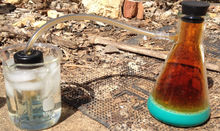Nitric acid
Nitric acid is a strong acid with the formula HNO3. It is a mineral acid, along with hydrochloric, sulfuric, perchloric, and phosphoric acids. It is a powerful oxidizing agent, especially when mixed with sulfuric acid, which produces the nitronium ion in situ.
Contents
Properties
Chemical
Nitric acid is an oxidizing acid at room temperature. It is often used in the nitration of organic compounds. It is capable of dissolving metals such as copper and silver due to its oxidizing nature, and will release toxic nitrogen dioxide as an oxidation by product.
- Cu + 8 HNO3 → 3 Cu(NO3)2 + 2 NO + 4 H2O
Physical
Concentrated nitric acid is a clear solution with a density of about 1.2 g/ml. When the concentration of the acid surpasses 70%, it becomes classified as fuming nitric acid, this can be identified by visible fuming when air is blown into it. Nitric acid in concentrations above 90% fumes extremely profusely on any contact with air. It forms an azeotrope with water at 68% concentration, which makes it difficult to produce the pure substance.
Availability
Nitric acid is available from lab suppliers like Elemental Scientific and Duda Diesel. While the acid itself is not expensive, it requires a mandatory HAZMAT shipping fee of $37.50, making this acid rather expensive for the amateur chemist.
Preparation
The classic method of laboratory synthesis of nitric acid is described in a sub-article:
Glauber's nitric acid synthesis
A somewhat less efficient method of producing nitric acid is by the reaction of a mixture containing sulfuric acid and a nitrate salt with copper metal, generating large amounts of nitrogen dioxide gas. The gas may then be bubbled into hydrogen peroxide or water, with hydrogen peroxide producing a higher yield.
Sodium bisulfate can also be use to replace sulfuric acid, however doing so will release nitrogen dioxide rather than nitric acid.
It is possible to produce nitric acid with an Ostwald reactor, or by reacting nitrogen and oxygen in air with an electric spark.
If you need to quickly whip up some dilute nitric acid, you can use the "quick and dirty" method, namely reacting calcium nitrate with sulfuric acid. This method has two downsides: first, even if your reagents are in a perfectly stoichiometric ratio, the resulting acid is still contaminated by a small amount of calcium sulfate that managed to stay in solution. Second, the precipitate of calcium sulfate is incredibly messy and voluminous, the acid looks like sour cream and it is almost impossible to decant it properly. Use this method only if you have a vacuum filtering set. This low-grade acid can be distilled to yield azeotropic nitric acid.
Projects
Nitric acid can be used for many projects including make nitrate salts. When mixed with concentrated sulfuric acid or hydrofluoric acid, nitric acid acts like a base and releases a nitronium ion:
- 2H2SO4 + HNO3 → NO2+ + 2HSO4- + H2O
This mixture, known as mixed acid can be used for nitrating many organic compounds.
Other:
- Make oxalic acid
- Make aqua regia
- Purify silver
Handling
Safety
Nitric acid solutions are highly corrosive and will stain the skin yellow as the proteins are nitrated. Care should be taken to not let nitric acid contact the skin. Nitrates should not be used with hydrochloric acid, because this generates nitrosyl chloride.
When handling fuming nitric acid, wear butyl rubber gloves. Other types of rubber may react extremely violently with nitric acid of this concentration. If you don't have butyl rubber, don't wear gloves at all: damage done to your bare hands will be lesser than what rubber on fire can do to you. Nitric acid in general reacts with rubber; do not try to distill it in apparata that contain rubber parts. Use ground glass joints or a retort when distilling nitric acid, especially of fuming concentration.
Storage
Nitric acid is incompatible with most plastics due to its oxidizing nature, though bottle lids made of polypropylene (PP) are acceptable. High concentrations of nitric acid are light sensitive and should be kept in amber glass bottles with ample headroom to prevent pressure build up from nitrogen oxides.
Disposal
Nitric acid can be neutralized with neutralizing compounds, such as carbonates, bicarbonates, oxides, hydroxides. Calcium carbonate is a good neutralizing agent, and, as long as the acid isn't contaminated with heavy metals, the resulting calcium nitrate can be discarded in ground or poured down the drain.

